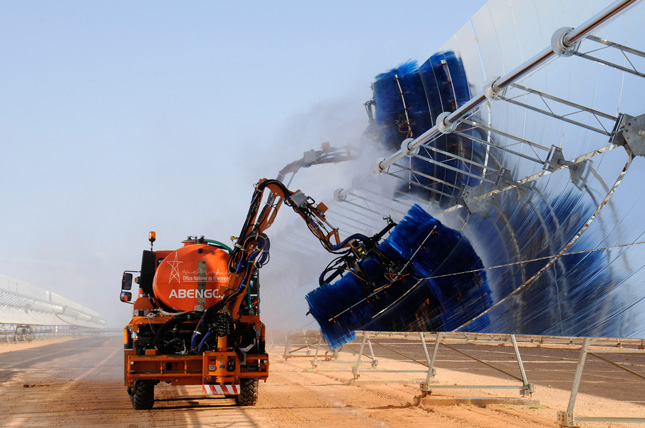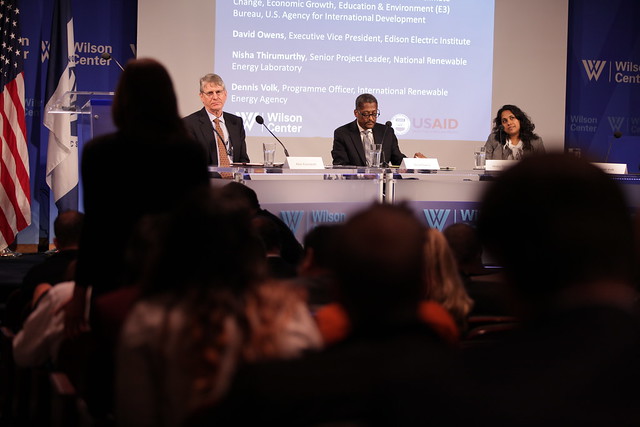-
Zero-Emission Energy for 1.3 Billion People? Scaling Up Renewable Energy in the Developing World [Part One]
November 12, 2015 By Graham Norwood
The renewable energy sector has reached a critical inflection point where costs are competitive with fossil fuels and investment is ramping up in a big way, said more than a dozen experts at a day-long conference co-hosted by ECSP and the U.S. Agency for International Development’s Office of Global Climate Change on October 27.
2014 was the first year in four decades that the global economy grew without CO2 emissions rising in tandem – a monumental achievement and an encouraging sign that the tide may be turning in the battle to avoid the worst effects of climate change.
“Never before have we seen such incredible alignments between the tech costs, the will and wants of even the largest buyers, the motivations of the utilities to actually work with us, and the regulator,” said Alex Perera, acting director of the World Resources Institute’s Global Energy Program. “I’m really optimistic about the opportunities going forward.”
Ahead of the 21st Session of the Conference of the Parties to the United Nations Framework Convention on Climate Change (COP-21), at least 164 countries have set renewable energy targets, which are seen as key to preventing catastrophic warming.
“I’ve been following the climate change negotiations since…before there was a climate change convention, and for the first time, I have a sense of optimism about where the negotiations are going,” said Charles Feinstein, director of energy and extractives at the World Bank.
Net investment in renewable sources of electricity has outpaced fossil fuels five years in a row, and the trend shows no sign of stopping. An estimated 28 percent of today’s global power generating capacity is powered by renewable sources. Renewable energy will make up almost 60 percent of new generating capacity installed over the next 25 years, and two thirds of the expected $12 trillion in new generating capacity investments, said Carrie Thompson, deputy director of USAID’s Regional Development Mission for Asia.
Finding a way to bring electricity to the 1.3 billion people who don’t yet have access to it while maintaining, and ultimately lowering, current emissions levels is a major development goal. But the proliferation of renewable energy has other knock-on effects that make it a priority as well.
Sustainable Development Benefits
The push for renewable energy is occurring in the context of the United Nations’ 2030 Agenda for Sustainable Development, which lists as its seventh goal to “ensure universal access to affordable, reliable, sustainable, and modern energy” while “increas[ing] substantially the share of renewable energy in the global energy mix.”
“SDG 7 is not just about energy in and of itself,” said Richenda Van Leeuwen, executive director for energy and climate at the UN Foundation, a U.S. nonprofit that supports the work of the United Nations. “We’re really trying to look in terms of driving sustainable outcomes across education, across health, across gender equity, and income increases as well.” The economic benefits of electrification are obvious enough, but the links between clean energy, health, gender, and education are less well known.
90 million children in sub-Saharan Africa go to primary schools without electricityAs Van Leeuwen pointed out, low levels of electrification often correlate with high maternal and neonatal mortality rates. This is in part because women in developing countries with limited electricity have high rates of exposure to smoke from cooking with kerosene and other fuels – both compared to women elsewhere and to men in their own households, who spend less time in the kitchen. The UN Foundation’s Global Alliance for Clean Cookstoves is thus integral to its work on sustainable energy.
In rural areas, lack of electricity at health care facilities also takes a toll on women and newborns. The UN Foundation is ramping up work in Ghana, Malawi, Tanzania, and Uganda to research the relationship between electrical power and the quality of health care, and is also studying more efficient health care appliances.
Without power, it’s also harder for young people to get the education they need. Ninety million children in sub-Saharan Africa go to primary schools without electricity. “We as a world have no excuse for any child being educated and studying at night and needing kerosene or candles,” said Van Leeuwen.
Distributed renewable energy – that is, energy generated by small, decentralized sources as opposed to large-scale plants that deliver conventional power to a national grid –promises to bring light and much more to these places. What’s more, renewable energy can provide these benefits without producing significant air pollution, like fossil fuels do. Some research suggests that renewables combined with efficiency measures can save millions of dollars in health care and mortality costs.
USAID has identified six building blocks for increasing renewable power generation in the developing world, said Allen Eisendrath, managing director of the Office on Global Climate Change. These include everything from competitive procurement processes and smart incentives that evolve over time, to “concentrated resource zones” and the importance of planning for climate change. These building blocks identify what countries need to do to drive large increases in renewable energy. “What are the requirements, other than low prices?” he said. “And what is driving low prices?”
A Grid Revolution
According to USAID, improving how renewable energy sources connect to existing electrical grids is key to continued growth. Unlike conventional power sources, such as coal or natural gas, renewable sources are intermittent, fluctuating based on environmental conditions such as overcast skies or windless days.
Household technologies like solar photovoltaic cells add a further layer of complexity because individual users have the potential to generate excess power that can be fed back into the grid and credited in a two-way billing arrangement known as net metering.
Balancing demand with intermittent availability and transitioning to net metering poses technological challenges for grid managers. China, for example, has struggled to fully utilize the large number of new wind turbines coming online, leading some experts to coin the term “garbage wind.”
However, the rise of distributed energy sources is an enormous opportunity for increasing energy independence. Power generation is no longer the sole dominion of the national grid or major utilities, especially in places not connected to the main grid.
Jake Cusack, a managing partner at the energy investment firm CrossBoundary, said Africa is now adding 10,000 off-grid customers a month. “In some ways, developing countries are now leapfrogging developed countries,” in terms of power supply heterogeneity, he said.
“The days of ‘grid extension or nothing’ are over,” said Mike Eckhart, a 40-year veteran of the energy industry who now serves as global head of environmental finance and sustainability at Citigroup. Solar photovoltaic cells are now available in everything from individual study lights that cost just $2, to small home solar installations able to power small appliances and charge phones, to micro and mini grids that can power small communities and eventually be integrated into the macro grid.
Pay as You Go
One major enabler of this growth in the developing world is innovation in how you pay for electricity. New services like Kenya’s M-PESA have revolutionized microfinance by allowing anyone with a cellphone to send and receive money. This has opened up access to millions of customers who previously might not have been able to purchase solar units because of their lack of credit.
“In some ways, developing countries are now leapfrogging developed countries”“There’s a strong connection with mobile money and the ability of solar to penetrate all over the [African] continent, and particularly in rural areas,” said Chaim Motzen, co-founder and managing director of Gigawatt Global. Motzen recently led the creation of East Africa’s first utility-scale solar field, an 8.5 megawatt facility in Rwanda.
Ethan Zindler, head of the Americas for Bloomberg New Energy Finance, described how a home solar unit works. For a modest upfront payment, customers receive small solar modules with outlets for charging phones and powering lights and other appliances. Using their cell phones, they purchase access to the module in hourly increments by entering a code from their service provider on their device. Service providers get paid back over time and customers get access to energy without having to pay prohibitive upfront costs.
This model of incremental payments is the general approach for even the largest renewable energy projects in the developing world. Utilities often lack the capital necessary to build major new installations, said Cusack. Development organizations and private investors therefore finance upfront costs, receiving returns on their investments through power purchase agreements that provide steady cash flows over a decade or two.
The falling price of renewable technologies has made clean energy an increasingly attractive profit sector. Development organizations are quick to point out the financial benefits of investing in clean technology to private investors, and in doing so, as explained in part two of “Scaling Up Renewable Energy in the Developing World,” they are underwriting a renewable revolution.
Event Resources:
- Jake Cusack’s Presentation
- Charles’ Feinstein’s Presentation
- Richenda Van Leeuwen’s Presentation
- Nisha Thirumurthy’s Presentation
- Melanie Vant’s Presentation
- Photo Gallery
- Video
Graham Norwood is a freelance writer based in Brooklyn, New York.
Sources: Borgen Magazine, Climate Central, d.light, The Economist, Renewable Energy Policy Network for the 21st Century, Sustainable Energy for All, World Energy Outlook, World Resources Institute.
Photo Credit: Solar panels being cleaned at the Ain Beni Mathar Integrated Combined Cycle Thermo-Solar Power Plant, Morocco, courtesy of the World Bank.
Topics: Africa, China, climate change, coal, COP-21, development, economics, education, energy, environment, environmental health, featured, From the Wilson Center, funding, gender, global health, international environmental governance, Kenya, mitigation, mobile technology, natural gas, natural resources, Rwanda, SDGs, solar, UN, USAID, video, wind
 A Publication of the Stimson Center.
A Publication of the Stimson Center.




